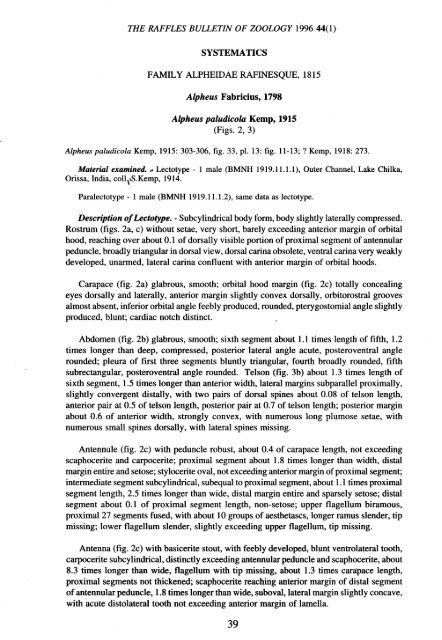a new species of freshwater snapping shrimp, alpheus cyanoteles
a new species of freshwater snapping shrimp, alpheus cyanoteles
a new species of freshwater snapping shrimp, alpheus cyanoteles
Create successful ePaper yourself
Turn your PDF publications into a flip-book with our unique Google optimized e-Paper software.
Alpheus paludicola Kemp, 1915<br />
(Figs. 2, 3)<br />
Material examined. "Lectotype - 1 male (BMNH 1919.11.1.1), Outer Channel, Lake Chilka,<br />
Orissa, India, colI.I,S.Kemp, 1914.<br />
Para1ectotype - 1 male (BMNH 1919.11.1.2), same data as lectotype.<br />
Description <strong>of</strong> Lectotype. - Subcylindrical body form, body slightly laterally compressed.<br />
Rostrum (figs. 2a, c) without setae, very short, barely exceeding anterior margin <strong>of</strong> orbital<br />
hood, reaching over about 0.1 <strong>of</strong> dorsally visible portion <strong>of</strong> proximal segment <strong>of</strong> antennular<br />
peduncle, broadly triangular in dorsal view, dorsal carina obsolete, ventral carina very weakly<br />
developed, unarmed, lateral carina confluent with anterior margin <strong>of</strong> orbital hoods.<br />
Carapace (fig. 2a) glabrous, smooth; orbital hood margin (fig. 2c) totally concealing<br />
eyes dorsally and laterally, anterior margin slightly convex dorsally, orbitorostral grooves<br />
almost absent, inferior orbital angle feebly produced, rounded, pterygostomial angle slightly<br />
produced, blunt; cardiac notch distinct.<br />
Abdomen (fig. 2b) glabrous, smooth; sixth segment about 1.1 times length <strong>of</strong> fifth, 1.2<br />
times longer than deep, compressed, posterior lateral angle acute, posteroventral angle<br />
rounded; pleura <strong>of</strong> first three segments bluntly triangular, fourth broadly rounded, fifth<br />
subrectangular, posteroventral angle rounded. Telson (fig. 3b) about 1.3 times length <strong>of</strong><br />
sixth segment, 1.5 times longer than anterior width, lateral margins subparallel proximally,<br />
slightly convergent distally, with two pairs <strong>of</strong> dorsal spines about 0.08 <strong>of</strong> telson length,<br />
anterior pair at 0.5 <strong>of</strong> telson length, posterior pair at 0.7 <strong>of</strong> telson length; posterior margin<br />
about 0.6 <strong>of</strong> anterior width, strongly convex, with numerous long plumose setae, with<br />
numerous small spines dorsally, with lateral spines missing.<br />
Antennule (fig. 2c) with peduncle robust, about 0.4 <strong>of</strong> carapace length, not exceeding<br />
scaphocerite and carpocerite; proximal segment about 1.8 times longer than width, distal<br />
margin entire and setose; stylocerite oval, not exceeding anterior margin <strong>of</strong> proximal segment;<br />
intermediate segment subcylindrical, subequal to proximal segment, about 1.1 times proximal<br />
segment length, 2.5 times longer than wide, distal margin entire and sparsely setose; distal<br />
segment about 0.1 <strong>of</strong> proximal segment length, non-setose; upper flagellum biramous,<br />
proximal 27 segments fused, with about 10 groups <strong>of</strong> aesthetascs, longer ramus slender, tip<br />
missing; lower flagellum slender, slightly exceeding upper flagellum, tip missing.<br />
Antenna (fig. 2c) with basicerite stout, with feebly developed, blunt ventrolateral tooth,<br />
carpocerite subcylindrical, distinctly exceeding antennular peduncle and scaphocerite, about<br />
8.3 times longer than wide, flagellum with tip missing, about 1.3 times carapace length,<br />
proximal segments not thickened; scaphocerite reaching anterior margin <strong>of</strong> distal segment<br />
<strong>of</strong> antennular peduncle, 1.8 times longer than wide, suboval, lateral margin slightly concave,<br />
with acute distolateral tooth not exceeding anterior margin <strong>of</strong> lamella.
















